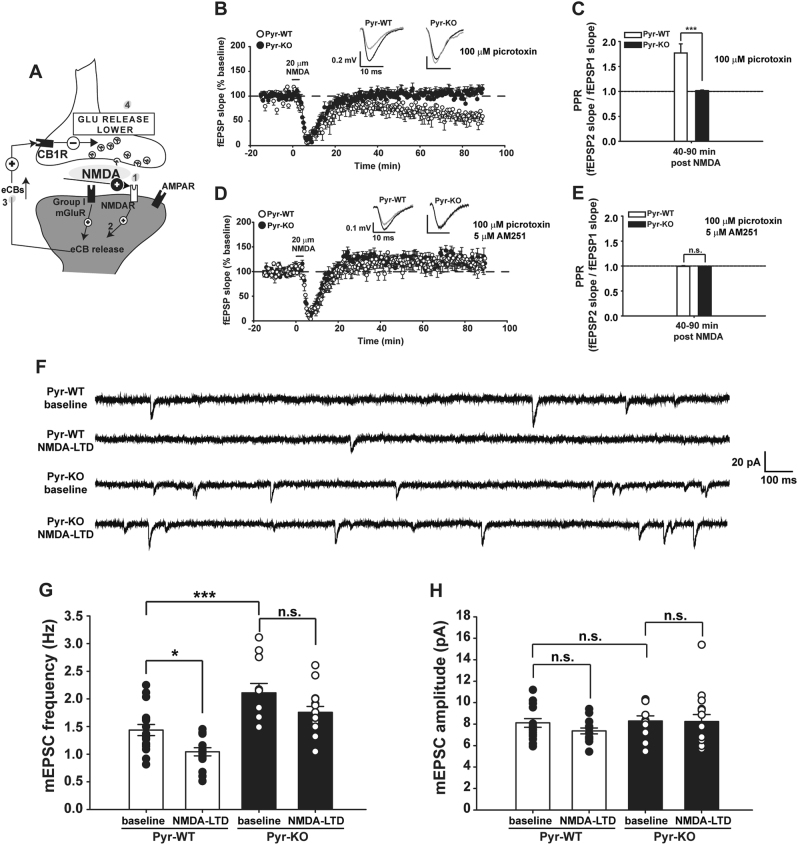Fig. 5.
NMDA-LTD and NMDA-dependent synaptic pruning is abolished in Pyr-KO mice. a Cartoon of a CA3-CA1 synapse depicting the sequential effect of bath-application of NMDA [1] on eCB release [2], activation of CB1Rs [3], and lowering glutamate release [4]. b Three minute 20 µM NMDA induces persistent LTD in Pyr-WT (71.3 ± 0.96%; n = 12 slices/4 mice; p < 0.001 relative to baseline); no effect in Pyr-KO (103.6 ± 1.03 %; n = 10 slices, 4 mice); p < 0.001, 2-Way RM Anova. c PPR for NMDA-LTD in Pyr-WT: 1.76 ± 0.14 (n = 12 slices/4 mice) vs. Pyr-KO: 1.01 ± 0.16 (n = 10 slices, 4 mice); p < 0.001, 2-Way RM Anova. d NMDA-LTD in Pyr-WT in the presence of 5 µM AM251: 120.3 ± 1.5 % (n = 11 slices/4 mice) vs. Pyr-KO: 122.3 ± 1.0 % (n = 8 slices/3 mice); p = 0.37, 2-Way RM Anova. e PPR during NMDA-LTD in AM251 is comparable between Pyr-WT (0.994 ± 0.013; n = 11 slices/4 mice) vs. Pyr-KO (0.99 ± 0.015; n = 8 slices/3 mice); p = 0.73, 2-Way RM Anova. Data averaged during period from 40 to 90 min post-induction. f Example traces of mEPSCs from Pyr-WT and Pyr-KO before and after induction of NMDA-LTD with a brief (3 min) pulse of 20 µM NMDA. g Bar-graph of average mEPSC frequency, with overlaid individual cell values (black and white symbols). Pyr-WT baseline: 1.44 ± 0.10 Hz (n = 17 cells/6 mice) vs. Pyr-WT NMDA-LTD: 1.04 ± 0.07 Hz (n = 15 cells/6 mice); p = 0.047. Pyr-WT baseline vs. Pyr-KO baseline: 2.11 ± 0.17 Hz (n = 11 cells/4 mice); p = 0.001. Pyr-KO baseline vs. Pyr-KO NMDA-LTD: 1.76 ± 0.11 Hz (n = 15 cells/4 mice); p = 0.153. One-Way Anova with post-hoc Tukey for multiple comparisons. h Bar-graph of average mEPSC amplitude, with overlaid individual cell values (black and white symbols). Pyr-WT baseline: 8.11 ± 0.41 (n = 17 cells/6 mice) vs. Pyr-WT NMDA-LTD: 7.36 ± 0.27 (n = 15 cells/6 mice); p = 0.652; Pyr-KO baseline: 8.29 ± 0.48 (n = 11 cells/4 mice) vs. Pyr-KO NMDA-LTD: 8.23 ± 0.66 (n = 15 cells/4 mice); p = 1.00. Pyr-WT baseline vs. Pyr-KO baseline: p = 0.99. One-Way Anova with post-hoc Tukey for multiple comparisons.

